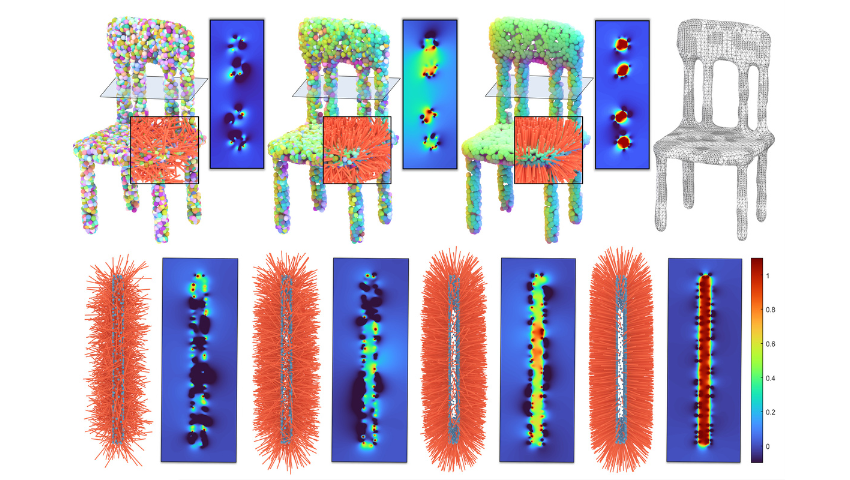Image Credit: “Globally Consistent Normal Orientation for Point Clouds by Regularizing the Winding-number Field” © 2023Rui Xu, Shiqing Xin, Mingyan Jiang, Changhe Tu, Shandong University; Zhiyang Dou, The University of Hong Kong; Ningna Wang, Xiaohu Guo, The University of Texas at Dallas; Shuangmin Chen, Qingdao University of Science and Technology; Wenping Wang, Texas A&M University
The sun is shining on the SIGGRAPH 2023 Technical Paper “Globally Consistent Normal Orientation for Point Clouds by Regularizing the Winding-number Field.” SIGGRAPH caught up with Rui Xu, first author on the team behind this fascinating research, to shed light on the inspiration behind their work, technical difficulties they faced along the way, and how they envisioned it being used in the future. Be prepared to be blown away!
SIGGRAPH: Share some background about “Globally Consistent Normal Orientation for Point Clouds by Regularizing the Winding-number Field.” What inspired this research?
Rui Xu (RX): We propose a method that can estimate globally consistent normal vectors of point clouds, which we call GCNO (Globally Consistent Normal Orientation). It was inspired by our interest in the winding number. The existing work points out that we need to have the direction of the point cloud, that is, the normal direction, to calculate the winding number so that we can use it to determine the inside and outside of the point cloud. But why can’t this process be reversed? If we already knew what the winding number field looks like, can we determine the normal vector of the point cloud? So, we created this paper.
SIGGRAPH: Tell us how you developed this work. What problems does it solve?
RX: As mentioned, we needed to know what the winding number field looks like to get the normal vector. So, we hoped to use a series of functions to describe what a good winding number field “should” look like. Then we let the normal direction of the point cloud be used as a variable to optimize these description functions. When we minimize them, the normal vector currently is what we want. In summary, we only need a simple optimization, using the normal vector as a variable, and then we can get the globally consistent normal orientation.
SIGGRAPH: Did you face any challenges as you developed your research? What surprised you most during the process?
RX: The biggest challenge in this project was time, there was only about one month from the time the idea came to mind to the deadline of the SIGGRAPH 2023 Technical Papers program submissions. So, we worked very hard and invited many excellent collaborators to work together. We met almost every day and had a clear division of labor and cooperation.
What surprised me most during the process was the importance of the Voronoi sampling. At first, we all thought that random sampling near the point cloud was enough to support the regularization of the winding number field, but experiments told us that its effect was not good. So, we introduced the Voronoi sampling, which can more clearly represent the shape of the point cloud and ensure that the sampling is distributed both inside and outside the point cloud. It also ensured that our balance term could work properly, thus significantly improving the quality of optimization results. It significantly improved the quality of results on models like thin plates.
SIGGRAPH: How do you envision this research being used in the future?
RX: I think this is a very inspiring work. It has opened new tracks in the use of winding numbers, point cloud normal estimation, and even surface reconstruction. Although this work still has many shortcomings, such as running time and open surfaces, it will inspire researchers to continue to push this research forward.
SIGGRAPH: What was your favorite part of participating at SIGGRAPH 2023?
RX: What I like most are the technology companies in the Exhibition. It was so different from other conferences; it was so cool. I enjoyed collecting souvenirs from various well-known companies at the venue and talking with them.
In addition, the lectures given by companies are also very interesting, such as the SIGGRAPH 2023 Production Sessions presentation “Magic Made Real: How POSSIBLE and Riot Games Realize League of Legends for the Stage” and the SIGGRAPH 2023 Talks presentation “Linework in Spider-Man Across the Spider-Verse.” They all impressed me deeply.
SIGGRAPH: What advice do you have for those submitting to SIGGRAPH Technical Papers in the future?
RX: The SIGGRAPH Technical Papers program is difficult, and we needed to submit our most confident work to this track. This will be a tough battle, so be prepared for everything possible, rich experiments, creative ideas, clear writing, and even eye-catching pictures and tables are all important.
SIGGRAPH 2024 Technical Papers submissions information is now available! Submissions will be open soon — but for now — start prepping your research to be on display in Denver, 28 July–1 August.

Rui Xu, a final-year master student at the Interdisciplinary Research Center (IRC) of Shandong University. I am under the tutelage of Prof. Changhe Tu and Prof. Shiqing Xin. My research interests are computer graphics, computational geometry, point cloud reconstruction, and geometric modeling.



